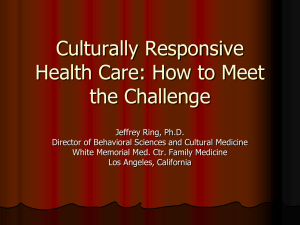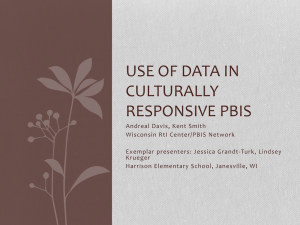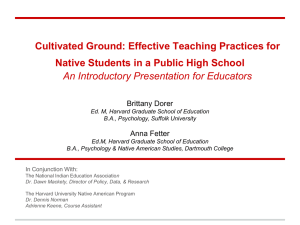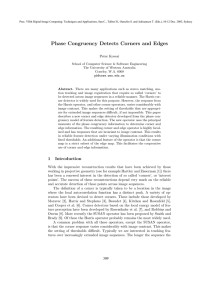Sanders.Exploring Child Care Cultural Congruency
advertisement
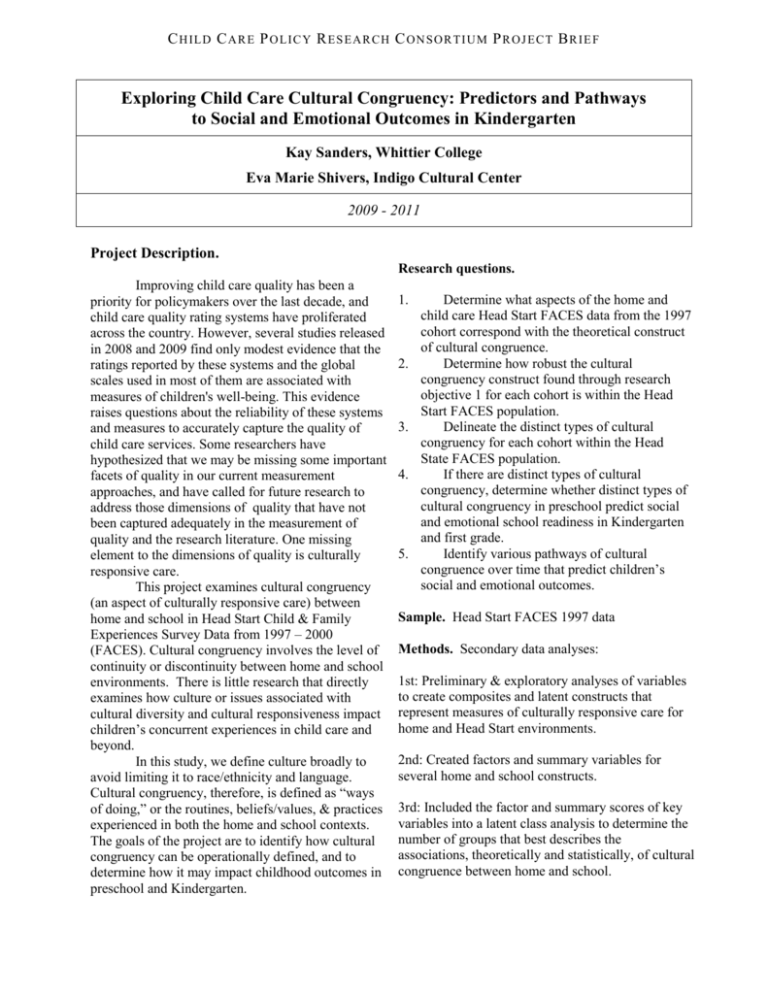
C H ILD C A R E P O LIC Y R ES EAR C H C ON S OR T I UM P R OJ EC T B R IE F Exploring Child Care Cultural Congruency: Predictors and Pathways to Social and Emotional Outcomes in Kindergarten Kay Sanders, Whittier College Eva Marie Shivers, Indigo Cultural Center 2009 - 2011 Project Description. Research questions. Improving child care quality has been a priority for policymakers over the last decade, and child care quality rating systems have proliferated across the country. However, several studies released in 2008 and 2009 find only modest evidence that the ratings reported by these systems and the global scales used in most of them are associated with measures of children's well-being. This evidence raises questions about the reliability of these systems and measures to accurately capture the quality of child care services. Some researchers have hypothesized that we may be missing some important facets of quality in our current measurement approaches, and have called for future research to address those dimensions of quality that have not been captured adequately in the measurement of quality and the research literature. One missing element to the dimensions of quality is culturally responsive care. This project examines cultural congruency (an aspect of culturally responsive care) between home and school in Head Start Child & Family Experiences Survey Data from 1997 – 2000 (FACES). Cultural congruency involves the level of continuity or discontinuity between home and school environments. There is little research that directly examines how culture or issues associated with cultural diversity and cultural responsiveness impact children’s concurrent experiences in child care and beyond. In this study, we define culture broadly to avoid limiting it to race/ethnicity and language. Cultural congruency, therefore, is defined as “ways of doing,” or the routines, beliefs/values, & practices experienced in both the home and school contexts. The goals of the project are to identify how cultural congruency can be operationally defined, and to determine how it may impact childhood outcomes in preschool and Kindergarten. 1. 2. 3. 4. 5. Determine what aspects of the home and child care Head Start FACES data from the 1997 cohort correspond with the theoretical construct of cultural congruence. Determine how robust the cultural congruency construct found through research objective 1 for each cohort is within the Head Start FACES population. Delineate the distinct types of cultural congruency for each cohort within the Head State FACES population. If there are distinct types of cultural congruency, determine whether distinct types of cultural congruency in preschool predict social and emotional school readiness in Kindergarten and first grade. Identify various pathways of cultural congruence over time that predict children’s social and emotional outcomes. Sample. Head Start FACES 1997 data Methods. Secondary data analyses: 1st: Preliminary & exploratory analyses of variables to create composites and latent constructs that represent measures of culturally responsive care for home and Head Start environments. 2nd: Created factors and summary variables for several home and school constructs. 3rd: Included the factor and summary scores of key variables into a latent class analysis to determine the number of groups that best describes the associations, theoretically and statistically, of cultural congruence between home and school. 4th: Use these classes (if feasible) to predict social and emotional outcomes in preschool and Kindergarten. Or, determine alternative indicators of congruency to include in prediction analyses. similar home and child care variables to create difference scores. These difference scores can then be used in prediction analyses. Implications for policy/practice Progress Update. One challenge with this study (due to the nature of secondary data analysis) is finding variables within the data set that are comparable between the home and school contexts. We found measurements that were comparable across both home/parent and the child care/teacher in the areas of: cultural awareness, school readiness, parent-teacher involvement, and disciplinary practices. Our analyses of FACES data to date revealed three distinct classes with ethnic differences across them and varying degrees of a lack of congruence between home and school among classes. Class I Characteristics: Higher proportion of black children. Higher levels of cultural awareness at home, but not at school. Low didactic and low DAP at school. Lower teacher sensitivity, and harsh discipline at home. Higher levels of harsh discipline at home. Low levels of parental involvement at school. Class II Characteristics: Diverse group of children. High cultural awareness activities at school, but not at home. Moderate levels of didactic and DAP at school. High levels of sensitivity at school, but moderate detachment at home. High levels of parental involvement at school. Class III Characteristics: Diverse group but lightly more White and Latino than the other two groups. Less likely to be ethnically matched with teacher. Moderate cultural awareness activities at home and school. High didactic and moderate DAP at school. High sensitivity at school, but detachment at home. Low parental involvement at school. While three distinct classes are apparent, further examination of them indicated that they will not be useful for a prediction analysis. Therefore, we are in the process of examining the data set for The direct focus on culture beyond race/ethnic markers is long overdue in child development research in general and in CCPRC work specifically. Findings from this research project can be used to inform child care quality policy discourse by delineating important links between practices, home and child care characteristics, and socialemotional childhood outcomes. Findings from this study also can inform future research that attempts to improve measures of child care quality specifically aimed toward childhood social and emotional outcomes and underrepresented populations. Specific Issues for CCPRC While this study is primarily exploratory, it brings up several questions that are pertinent to the work done by the members of CCPRC. Some issues or questions to consider are: Measurement of culture: what does it mean & can it be done? Going beyond race/ethnicity/language when addressing culture How can culture be included across themes addressed by CCPRC? Are culturally responsive classrooms higher in environmental quality as measured by standardized instruments? Are there associations between culturally responsive classrooms and children’s school readiness? Which structural and organizational factors influence teachers’ culturally responsive pedagogies? Pitfalls of secondary data analyses Contact Information Kay Sanders, Ph.D. Associate Professor Child Development, Whittier College, ksanders@whittier.edu Eva Shivers, Ph.D., J.D. Director, Indigo Cultural Center, eshivers@indigoculturalcenter.com Key Topics Please select all that apply and briefly describe/explain. This information will be used internally in planning the CCPRC Annual Meeting. Child Care Subsidy Policies & Practices e.g., How do policies and practices influence parents’ child care decisions, parental and/or child outcomes, providers’ behavior, access to quality child care? Collaboration, Integration, & Linkages e.g., What are characteristics of different types of collaborations? What are reasonable outcomes to expect? What are we learning from coordination across different systems? What is the value added of effective collaborations at the state and local levels? Quality Frameworks How well are QRIS living up to promise of improved outcomes at the systems, provider, family and child levels? How are they influencing parent decisions, professional development, workforce issues? What are we learning about collaborative professional development strategies and effective targeting of quality resources? Parents & Families What do we know about parent decision-making and how it is influenced by issues such as culture, employment, subsidy policies? What other family-level constructs are relevant to child care policies/practices? Other : Understanding and Integrating Cultural Diversity into Child Care Research & Policy It is important to understand how culturally responsive care is embedded in our definitions of and standards for measuring “quality.” This will help ensure that we are building a system that is culturally responsive to the families and communities it serves. Cultural congruency is strongly connected to the theme of Parents and Families. Our findings regarding congruent versus non-congruent homeschool contexts may have implications regarding parental decision-making and familial connectedness toward child care programs within a community. While this topic is pertinent to many themes that are already part of the conference, it can also stand on its own and thereby provide a more indepth examination of cultural responsiveness / cultural diversity in child care and the implications that it can/may have for child care practices, policy, and childhood outcomes. I and my colleague (Eva Shivers) are available to organize the theme and we also know of presenters that can contribute to this important topic.
